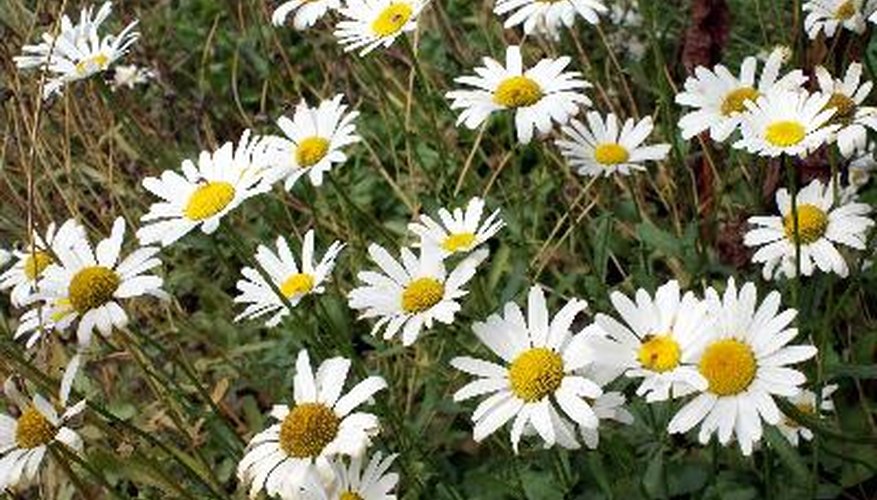Coreopsis is a genus of plants belonging to the sunflower (Asteraceae) family. Asteraceae is the largest family of flowering plants in the world. There are annual and perennial species of coreopsis, all of which bear flowers. A number of coreopsis are native to the United States and North America. Pruning coreopsis is an important part of maintaining plant health and preventing the unwanted spread of plants. There are two ways coreopsis must be pruned, deadheading and cutting back.
Coreopsis Genus
Coreopsis is a genus of plants that bear daisy-like flowers in yellow, white, pink and red. Some species' flowers have dark brown, mahogany or maroon centres. Coreopsis flower twice annually, in the midsummer and autumn. There are 33 species of coreopsis indigenous to the United States, including all types used in gardening. Among the coreopsis species commonly used in gardening are tickseed (Coreopsis grandiflora), thread-leaf coreopsis (C. verticillata), golden tickseed (C. tinctoria), pink tickseed (C. rosea), lanceleaf tickseed (C. lanceolata) and mouse-ear tickseed (C. auriculata). Dozens of cultivars and hybrids derived from these species have been created just for landscaping and gardening. Coreopsis will attract butterflies to the garden.
- Coreopsis is a genus of plants that bear daisy-like flowers in yellow, white, pink and red.
- There are 33 species of coreopsis indigenous to the United States, including all types used in gardening.
Deadheading
Deadheading is a special pruning process by which gardeners cut flowers from a plant without cutting any of the stem or foliage. This practice is necessary with species of coreopsis to promote continued flowering and prevent the spread of the plant in the garden -- specimen not deadheaded will drop seeds. Pennsylvania State University recommends deadheading coreopsis every five to seven days during flowering periods, both in the summer and the fall. Gardeners should deadhead only flowers that are dead or wilted. University of Illinois Extension horticulturalist Lucille Saunders provides more specific instructions. According to Saunders, tickseed (C. grandiflora) should be deadheaded daily while flowering, and pruned down to the foliage in August and September. Thread-leaf coreopsis should be sheared of all deadheads in one feel swoop at the end of August and not pruned again until the early spring.
- Deadheading is a special pruning process by which gardeners cut flowers from a plant without cutting any of the stem or foliage.
- This practice is necessary with species of coreopsis to promote continued flowering and prevent the spread of the plant in the garden -- specimen not deadheaded will drop seeds.
Cutting Back
Cutting back is a standard pruning practice. There are two types of cutting back, minimal and radical. Minimal cutting back is simple pruning done to maintain plant health and promote growth -- it is the process of cutting stems back to the foliage and removing dead flowers and leaves. University of California Davis horticulturalist Yvonne Savio recommends cutting coreopsis species in September. However, Savio warns that species should not be cut back beyond green foliage to the woody growth, as over-pruning can ruin a specimen. Cut back only after deadheading is complete. Radical cutting back is a method of promoting vigorous new growth in struggling or dying specimen. It entails cutting the plant back all the way to the ground. This should be done before the first flowering in the summer though not during the winter. Plants pruned in the late fall or winter will seed and spread.
- Cutting back is a standard pruning practice.
- Minimal cutting back is simple pruning done to maintain plant health and promote growth -- it is the process of cutting stems back to the foliage and removing dead flowers and leaves.
Culture and Use
Proper culture is as important as pruning in maintaining the health of coreopsis. Cultivars of the genus are designed to be tolerant of cold, heat, humidity and varying soil types. Coreopsis species will flourish only in full sun exposure and prefer soil of medium moisture. Coreopsis may spread invasively via underground stems, particularly in moist and sandy soil. Fine Gardening magazine recommends coreopsis for beds and borders, as a cut-flower plant and as a naturalised specimen.
- Proper culture is as important as pruning in maintaining the health of coreopsis.
- Coreopsis may spread invasively via underground stems, particularly in moist and sandy soil.
